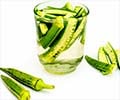Int. J. Biol. Macromol.
Extractions and rheological properties of polysaccharide from okra pulp under mild conditions.
Li Y, Wang X, Lv X, Wang X, Wang X, Cui J, Yan M
This study investigated the extraction of polysaccharide from okra pulp (POP), its chemical components, and rheological properties. The results showed ...
Read More
Source: PubMed
Mol. Plant Microbe Interact. 2020 Jan 20
Genome Sequences of Defoliating Strain XJ592 and Non-defoliating Strain XJ511 of Verticillium dahliae.
Li HY, Dai J, Qin J, Shang W, Chen JY, Zhang L, Dai X, Klosterman SJ, Xu X, Subbarao KV, Fan S, Hu X
Verticillium dahliae is a widely distributed soilborne pathogen that causes vascular wilt in more than 200 plant species. Defoliating and non-defoliat ...
Read More
Source: PubMed
J Texture Stud 2020 Jan 18
Clustering of instrumental methods to characterize the texture and the rheology of slimy okra (Abelmoschus esculentus) suspensions.
Savouré T, Dornier M, Vachoud L, Collignan A
Okra (Abelmoschus esculentus) is one of the ingredients widely used in African gastronomy because of the unique slimy texture it gives to sauces. Howe ...
Read More
Source: PubMed
Arch. Virol. 2020 Jan 09
Molecular characterization of two previously undescribed begomovirus-associated alphasatellite molecules infecting malvaceous species in Cameroon.
Leke WN, Kvarnheden A, Avelar S, Brown JK
Two begomovirus-associated alphasatellites were isolated from okra and a malvastrum plant (Malvaceae) in Cameroon. The complete nucleotide sequences o ...
Read More
Source: PubMed
Virusdisease
Occurrence and variability of begomoviruses associated with bhendi yellow vein mosaic and okra enation leaf curl diseases in south-western India.
Naresh M, Khan ZA, Kumar R, Kale SP, Patil VM, Rajput JC, Dasgupta I
Bhendi yellow vein mosaic disease (BYVMD) and Okra enation leaf curl disease (OELCuD) are common diseases of okra/bhendi [Abelmoschus esculentus (L.) ...
Read More
Source: PubMed
Int. J. Biol. Macromol.
Extractions and rheological properties of polysaccharide from okra pulp under mild conditions.
Li Y, Wang X, Lv X, Wang X, Wang X, Cui J, Yan M
This study investigated the extraction of polysaccharide from okra pulp (POP), its chemical components, and rheological properties. The results showed ...
Read More
Source: PubMed
Mol. Plant Microbe Interact. 2020 Jan 20
Genome Sequences of Defoliating Strain XJ592 and Non-defoliating Strain XJ511 of Verticillium dahliae.
Li HY, Dai J, Qin J, Shang W, Chen JY, Zhang L, Dai X, Klosterman SJ, Xu X, Subbarao KV, Fan S, Hu X
Verticillium dahliae is a widely distributed soilborne pathogen that causes vascular wilt in more than 200 plant species. Defoliating and non-defoliat ...
Read More
Source: PubMed
J Texture Stud 2020 Jan 18
Clustering of instrumental methods to characterize the texture and the rheology of slimy okra (Abelmoschus esculentus) suspensions.
Savouré T, Dornier M, Vachoud L, Collignan A
Okra (Abelmoschus esculentus) is one of the ingredients widely used in African gastronomy because of the unique slimy texture it gives to sauces. Howe ...
Read More
Source: PubMed
Arch. Virol. 2020 Jan 09
Molecular characterization of two previously undescribed begomovirus-associated alphasatellite molecules infecting malvaceous species in Cameroon.
Leke WN, Kvarnheden A, Avelar S, Brown JK
Two begomovirus-associated alphasatellites were isolated from okra and a malvastrum plant (Malvaceae) in Cameroon. The complete nucleotide sequences o ...
Read More
Source: PubMed
Virusdisease
Occurrence and variability of begomoviruses associated with bhendi yellow vein mosaic and okra enation leaf curl diseases in south-western India.
Naresh M, Khan ZA, Kumar R, Kale SP, Patil VM, Rajput JC, Dasgupta I
Bhendi yellow vein mosaic disease (BYVMD) and Okra enation leaf curl disease (OELCuD) are common diseases of okra/bhendi [Abelmoschus esculentus (L.) ...
Read More
Source: PubMed








